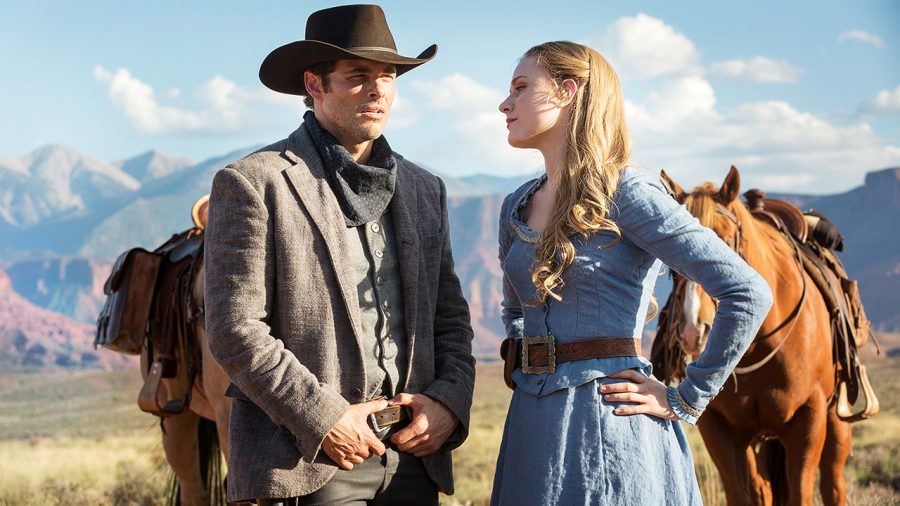These Violent Delights Have Violent Ends: A Westworld review
January 27, 2017
“Am I a real boy?” is what Pinocchio asked his fairy godmother some 75 years ago in a Disney film. Inside its dusty Western violence, its disgust with human behavior and its twisting, sprawling storyline, this simple question sits at the heart of the first season of the acclaimed and popular HBO series “Westworld.”
Taking place inside a massive, high-priced, interactive Wild West theme park, we are immediately introduced to Dolores.
Dolores, played brilliantly by Evan Rachel Wood, is the oldest of the numerous “hosts” in the theme park.
The hosts in the park are incredibly lifelike robots who play out storylines for their paying, human “guests.”
Guests are allowed to slip in and out of these storylines as they please; however, we are repeatedly shown that most guests simply want to murder, have sex with or otherwise molest the robot hosts in the interest of playing out their basest fantasies.
The park employs a massive team of engineers and eventually as the storylines play out, the hosts are simply repaired, reset and returned to their storyline loops.
Wood’s Dolores, set in her storyline as a naïve rancher’s daughter, is really the personification of the of the crux of the show’s first season.
The opening seconds of “Westworld” sees Dolores being softly interrogated by an off screen voice. She is unclothed, sitting in what could be a laboratory, and is being asked questions as one would ask Siri for help with his or her computer.
There are other vocal hints that she is no ordinary person as we see a stray housefly crawl across her eyeball with nary a trace of reflex. The off screen voice asks, “Have you ever questioned the nature of your reality?” As Dolores answers “No,” we are transported to see a lustrous Dolores waking up to a lush Western environment and our jarring initial meeting with Dolores slowly fades from memory as we sink into the sepia toned reality that Dolores is a part of.
We are initially introduced to her as a modest, well-heeled host, almost a greeter, to the new human arrivals as they disembark the restored Old West train into the just-too-perfect Old West town of Sweetwater.
Dolores is our barometer for the show. As the shows plots and timelines unfurl and reveal themselves, we see her slowly (too slowly, in some cases) come unspooled as she becomes more and more aware of what exactly she really is, or in this case, what she isn’t.
While Dolores is “Westworld”’s philosophical soul, Maeve, the world weary madam in Sweetwater’s brothel, is the show’s beating heart.
Played by Thandie Newton, Maeve, like Dolores, slowly comes to realize that she is not who, or what, she thinks she is. But, unlike Dolores’ head-spinning struggle to comprehend and come to grips with her own existence, Maeve’s approach to her situation is more pragmatic. Get out.
Maeve, unlike Dolores, seems to have a more direct understanding about what is happening in the park and begins to devise and execute plans to enable her to leave.
Her interactions with the theme park’s engineering staff below the park are particularly interesting and fun, although most of these scenes leave Newton to play her character with little or no clothing, which becomes distracting.
Maeve’s swashbuckling story of escape that plays out over the ten episodes is the straight-forward antithesis to Dolores’s time-hopping existentialism. It keeps the complex show from getting stuck in it’s own head and drives the show forward when it needs a push.
It could be argued that while Wood, Newton and others in the show put in wonderful performances (Jeffrey Wright’s turn as Bernard the longtime company man is especially compelling), the real star is the show’s complex set of plots and timelines. Dolores’s story alone comprises 3 separate plots along the show’s 3 separate timelines.
In an interview with John Kolbin of the New York Times in December, Jonathan Nolan, one of the creators of “Westworld,” talked about constructing the complex plotlines and timelines of the show.
Nolan said, “All of these things had been layered together so, so carefully from the beginning, which is what makes it so difficult to write.”
He added, “You’re writing at least three separate timelines that have to interact with one another as if it’s all ever present. … We were layering this idea of a nonlinear experience experienced linearly.”
The three separate timelines, set in the show’s present day, 30, and 37 years before, are not, as Nolan indicated, presented initially as separate timelines. It is this slow realization for the viewer over the course of the first season that is the show’s real treat.
Yes, “Westworld,” would like us to consider the plight of these exploited androids and asks us to consider our own nature as we watch them struggle with their own. It would like us to sit and contemplate what it really is that separates humans from the newly self-aware hosts in this vast theme park.
And it would like us to shudder as we watch the humans in this theme park succumb to their worst selves.
However, the pleasure of “Westworld” lies in the “Inception”-esque unravelling of the stories and piecing together everything as more and more is revealed.
The show did suffer from its popularity by having many of its twists untwisted online before the show ran its course. It, also, at times get bogged down by the weight of it own existential questions.
But these problems are worth managing in the end, and while the second season won’t premier until 2018, it would appear that HBO has another winner in its stable.

